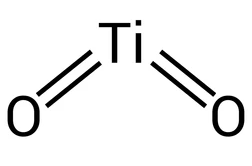
Titanium dioxide
What is Titanium Dioxide?
Titanium dioxide, often abbreviated as TiO2, is a naturally occurring white pigment and a widely used inorganic compound in various industries. It exists in different forms, with the most common being rutile and anatase. Titanium dioxide is renowned for its exceptional opacity, brightness, and high refractive index, making it an essential ingredient in a wide range of applications.
Applications of Titanium Dioxide
- Paints and Coatings: Titanium dioxide is a primary component in the formulation of paints and coatings. It provides opacity and brightness to paint films, enhancing their covering power and UV resistance. In addition, it contributes to the durability and longevity of exterior coatings.
- Plastics and Polymers: The plastic industry relies on titanium dioxide as a white pigment and UV stabilizer. It is used in the production of white plastic products, including packaging materials, automotive parts, and consumer goods.
- Cosmetics and Sunscreens: Titanium dioxide is used in cosmetics, particularly in sunscreens and skin care products, as a UV-blocking agent. It effectively reflects and scatters UV radiation, providing protection against harmful sun exposure.
- Ceramics: In the ceramics industry, titanium dioxide is utilized to enhance the whiteness and opacity of ceramic glazes and tiles. It also contributes to the structural strength of ceramics.
- Paper and Printing: Titanium dioxide is incorporated into paper coatings to improve print quality and brightness. It enhances the paper’s opacity, allowing for better ink retention and reduced show-through in printed materials.
Titanium Dioxide: Benefits
The use of titanium dioxide offers several key benefits:
- High Opacity: Titanium dioxide is renowned for its exceptional opacity, which allows for excellent coverage and hiding power in paints, coatings, and plastics.
- UV Protection: In sunscreens and cosmetics, titanium dioxide serves as a highly effective UV-blocking agent, safeguarding the skin from harmful ultraviolet rays.
- Durability: Titanium dioxide enhances the durability and longevity of various products, including paints and plastics, by providing resistance to weathering and UV degradation.
- Non-Toxic: Titanium dioxide is considered safe for human use in cosmetics and sunscreens and is generally recognized as safe (GRAS) in food applications.
How Titanium Dioxide is Made
The production of titanium dioxide involves several key steps:
- Ore Extraction: Titanium dioxide is typically derived from naturally occurring titanium minerals, with ilmenite and rutile being the primary sources. These minerals are mined and processed to extract titanium dioxide ore.
- Chlorination: The ore is then subjected to a chlorination process using chlorine gas to convert the ore into titanium tetrachloride (TiCl4).
- Oxidation: Titanium tetrachloride is oxidized using oxygen or air, resulting in the formation of titanium dioxide particles.
- Purification: The titanium dioxide particles are purified to remove impurities, including iron, using various chemical processes.
- Formulation: The purified titanium dioxide is formulated into different grades and forms to suit specific applications, such as paints, plastics, cosmetics, and more.
In conclusion, titanium dioxide is a versatile and essential compound with a wide range of applications in industries such as paints, plastics, cosmetics, ceramics, and paper. Its outstanding opacity, UV protection properties, and durability make it a valuable ingredient in various products. Understanding its applications and production process highlights its significance in numerous industrial sectors and its contribution to enhancing the quality and functionality of everyday products.
Where can I buy Titanium dioxide in Europe ?
Contact us for Titanium dioxide availability and prices



